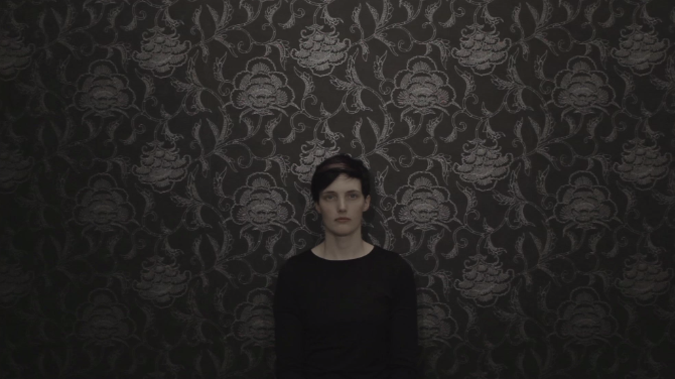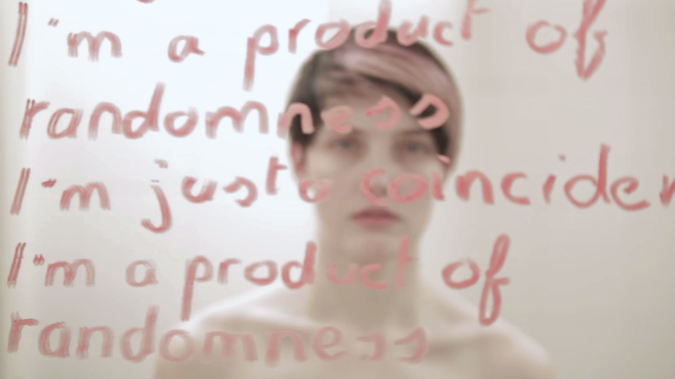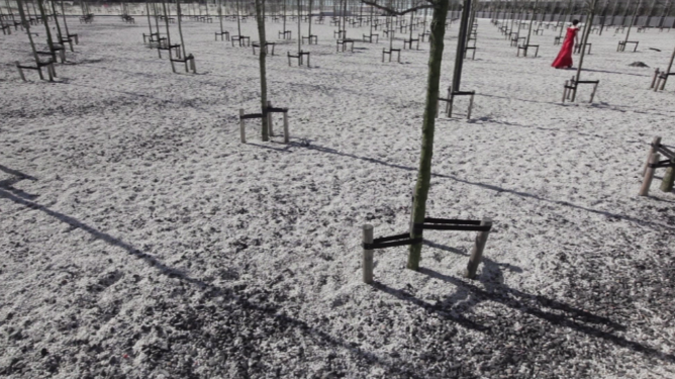User:Demet Adiguzel/Project Proposal Draft
WRITTEN SO FAR
Some thoughts while trying to articulate
(general into-- describes your method [ video, film, (still photos) audio &c about identity in flux, gender, religion, = how one defines it and how it defines you.
film about community [using my new camera] , which explores above, and uses methods [what?] outlined in this proposal... audio addressing the image, a collection of memories and places... [archive and memory-- the memory place is different...] )
The recurring concepts of my previous works are identity, gender and religion. I am interested in questions like
- How do we construct our identity?
- How does it construct us?
- What defines identity?
Many things like biological aspects in which we see the role of gender and hormones form the identity. Maybe our own identity is just a coincidence like being born as a man or a woman. The type of family and culture that we born into will shape the identity involuntarily. As a given name, is our identity that random? And knowing this why are we still so attached to it? In addition to what was given to us, we shape the rest and build our ego. We shape the rest with how we look and dress. The mask that is the body we own, the very shelter for the hidden, fragile soul, becomes the first thing that gives away a clue about our background, identity. We judge each other according to what we see, give labels to certain things that for us define the background, the groups, cultures, communities and roles. We simply become ‘other’ to each other. I was an ‘other’ my whole life. Born into a minority, never felt belonging to any group, I could not grasp the shape of my identity. When I migrate to another country the feeling was more obvious. Feeling lost and stateless, trying to find my identity; I ask these questions to myself. Maybe knowing the answers would not help anything or give a way to explore it all. For my graduation project, I want to explore what had construct my identity and made me me by the help of memories. Born into a small community with different religious beliefs than the majority, I had to hide my religious backgrounds from outside world to fit in. Living so many years undercover will be an element in my project. By exploring my memories, I aim to explore the culture I had to hide, the dominant outside culture and how religion played a role in my existence. I want to make a short film delving into my own experiences for identity, asking questions on roles, freedom, gender, class, loss ...
Descriptions on the last 2 works
Mirror Mirror On The Wall
Mirror Mirror On The Wall, is a 7-and-a-half-minute long video starting with the 30 year old female subject in front of a bathroom mirror in a blue top, doing her morning routines such as combing her middle-length hair and her bangs, doing make-up, brushing teeth. It is almost like surveillance footage, in low quality, poor lighting and unflattering angle. The footage is in the middle, not covering the whole screen, it is rather small so there is a big black frame around it.
During the video we see the subject seem modern and ordinary, looking at the mirror and getting ready while the camera shoots her in front of the mirror slightly from below. Meanwhile we hear the audio of telephone-like conversations, which may not make sense at first. It starts with a female voice telling how she saw something and what it meant to her, so the opening line is “It was a black blanket for me…” then we hear male voices trying to define something black and supposedly a dress.
The video goes on with the same shot, with different parts of three conversations in which a female voice and two male voices try to define and explain how someone seemed during a specific day. Meanwhile the footage still show the subject getting ready until she slightly leans down and reaches for something that we do not see in the frame. Afterwards we see her covering herself in a hood little by little turning into a chador.
While she concludes her morning routine with covering herself up with a cloth that hides her hair, a fourth voice asks a question “Did you ever wonder what was under(neath) the outfit?”, the three voices one by one reply “No”. We see the subject not moving after covering herself, her last action being getting in the chador, now she does not go further with getting prepeared; just looks at the mirror, then looks down.
The footage was shot by an iPhone 4 camera using natural light and was edited in a way to give a certain surveillance feel. The audio was taken from the conversations that were done with my class-mates as interviews on how they felt and found my appearance in class as a woman in a chador (as opposed to my normal self). During these conversations I asked them certain questions aiming to answer the question if they had felt anything different about me when they saw me wearing a chador, if they knew what that type of garment is used for. While editing I tried not to give away the subject of the interview till the end and tried to keep the suspense till I got in the chador in the footage.
For this video I spent several days in an outfit which I would not normally wear and obviously states the beliefs of the person who wears it. I wanted to see how I would feel in it and how would people react to me, to see if anything would change in the way people treat me. I came to class wearing the outfit and in the video, I included the interviews that I had made with the people I see almost everyday; my classmates.
In this video the interviews are revealed while the visuals show myself doing my morning routines in front of a bathroom mirror and then getting in the chador as an obvious transformation into another identity. I wanted it to be apparent that there is an absolute transformation with a simple piece of cloth and also emphasized it with the pieces from the interviews. I think I succeeded for this aim.
I also think that in terms of telling a story with the help of audio and images, this piece has a significant success. To compose the audio and video in order to tell a story, to combine them in a way that it starts with a suspense and ending with revealing the answers was my aim. For the audio, since the actual story is told by others, when it is combined with the images of myself, it makes it more interesting to watch.
In my opinion, the work could be more interesting if there were more conversations – more voices therefore (and hopefully) more interesting opinions and findings about the experiment I had in the outfit. As an alternative, the footage could be shorter so that the conversations can be more frequent.
In general I find this piece a good example of how the audio and image in my work can work together.
The Absence
The Absence is a 3 minutes 34 seconds of moving images looping as two screen installation. Totally silent videos start with almost abstract images. On the left hand side the screen is white and on the right hand side is gray. Both screens move and within the same shot there appears a brunette female in her twenties looking out the window which suggests that the abstract beginning scene was snow flakes floating out the window. Meanwhile the abstract bubbles in the right scene became clearer suggesting that it is surface of water being poured into a tub. When the scene slowly moves we see a foot appearing in the right screen while the left screen starts to show the female’s hand.
While the left screen changes to black blank screen, the female appears in a close up shot sleeping in the right one. In the next shot both of the screens we see the female staring at the camera with icy blue eyes. In the left screen she appears from her chest up, we see her shoulders naked. While she stares at the camera with a blank look, we also see some writings in front of her as if they were written on a mirror which she looks through to the camera. Slowly the focus of the camera changes to the writings and the female becomes blurred. Meanwhile on the right screen she appears in front of a black wallpaper with a pattern of gray flowers on it. She does not move. Both screens turn to black blank screens at the same time.
From week 6 till week 13, we have shot every weekend (with the exception of one weekend) once or twice. Some of the intended scenes could not be shot because of the time constraint – simply because of the season. For some of the scenes, the image was edited with special effects by the help of After Effects program. The general editing was done in Adobe Premiere. For all shoots Canon 5D Mk II camera was used.
In most of the scenes we see the reality shift, the viewer cannot be sure if it is real or just imagination. The reason I wanted to use two screens was that I wanted to give realities as different layers which are interactive with each other in a way. For instance; the opening scenes start with almost abstract images later composed to show the character. In left scene we start with her face and when we see her hand, the other screen reveals her foot slowly. We see the contrast of her beautiful face by her graceful being and brutally damaged (dancer) foot in water.
For most of my work I use symbols but try to avoid explaining everything by allegories. The certain elements of fairytales and their religious representations impress me. This work includes allusions to certain fairytales but more importantly, to religions.
In this work, I still am not satisfied with the outcome. During the shooting, I have thought of every scene and what they might mean. However even though the shooting was thoroughly done, there was not enough time to do the editing in the same manner. Therefore, I still see this work as a work-in-progress and try to work on it from time to time.
Since I am now exercising on the story telling with the images, I have re-edited this footage in order to tell a more concrete story and tried to only include the important symbols and scenes in one screen. That is because I think this piece is not too strong in telling the back story and since I (over)used the black blank screen in this piece, I think it prevents the audience to include themselves in the story.
I will be working on a way to use the strength of the images to grasp the attention and curiosity of the audience.
On the other hand, I will also make experiments to see the possibilities to intensify the images with audio.
More on
(what are you doing now and where do you want to take it? practical term---themes. )
currently experimenting with editing , photos and audio== this has come out of the above work
[next step: make text, to put the story behind the 2nd work, (currently without sound it needs something)
investigate possibilities of audio & image...
want to make new connection with audio and what you see... (la jetee)
motivation= all the above will be used to relate to the ideas about identity explicit in the above mentioned work...
work on instincts, make something and refine it...
Reading
- Carl Jung's autobiography for concept of memory
- Sculpting in Time : How can 'Image poetry' be possible
- Cocuklugun Soguk Geceleri by Tezer Ozlu : Analyzing her style for memories ::: time is irrelevant, memories call each other, collection of memories happening at the same time + sincere + bald (slapping with words)
- Reading books on Alevism
Autobigraphical works by Tarkovsky (Mirror), Nuri Bilge Ceylan (Kasaba)
for format style : La Jetee by Chris Marker
Writing Memories on cards
PROJECT PROPOSAL OUTLINE
Tentative Title
Remember this can change as your research evolves - also keep in mind that the title of your research does not have to be the eventual title of your exhibited final project.
General Introduction
A brief general introduction or abstract laying out the field you wish to research, possible key questions driving what you want to explore and how you will test these questions through practice.
Relation to previous practice
How does your research connect to previous projects you have done? Remember to briefly explain or describe related projects as the external is not familiar with your work.
Relation to a larger context
Meaning practices or ideas that go beyond the scope of your personal work. Write briefly about other projects or theoretical material which share an affinity with your project. For example, if you are researching urban interventions, you might talk about Situationist approaches to psychogeography, urban tactical media and activist strategies of reclaiming the streets. Or, if you want to explore the way data is tracked, you might touch upon the politics of data mining by referencing concerns laid out by the Electronic Frontier or highlight theoretical questions raised by Wendy Chun or others. (Keep in mind that we are *not* expecting well formulated conclusions or persuasive arguments in the proposal phase. At this juncture, it's simply about showing an awareness of a broader context, which you will later build upon as your research progresses.)
Practical steps
Describe how you will go about conducting your research through reading, writing and practice. In other words, through a combination of these approaches, you will explore questions or interests you have laid out in your general introduction. In this section you can help us understand how your project will come together on a practical level and talk about possible outcome(s). Of course, the outcome(s) may change as your research evolves, but it's important to have some idea of how your project might come together as a whole.
References
A list of references (Remember that dictionaries, encyclopedias and wikipedia are not references to be listed. These are starting points which should lead to more substantial texts and practices.) As with your previous essays, the references need to be formatted according to the Harvard method.) See: http://pzwart3.wdka.hro.nl/wiki/A_Guide_to_Essay_Writing#The_Harvard_System_of_referencing
Feel free to include any visual material to substantiate, illustrate or elucidate your proposal. For example use images to reference your work or that of others.



